Fire Safety (England) Regulations 2022: Guide and How We Can Help
Following the devastating Grenfell Tower Fire in 2017, the Grenfell Tower Inquiry was established. To meet the Inquiry’s Phase 1 recommendations, the Fire Safety (England) Regulations 2022 (the Regulations) were introduced. Unlike the Fire Safety Act 2021 which applies to England and Wales, the Fire Safety (England) Regulations 2022 only apply to England.
The Fire Safety (England) Regulations 2022 will come into effect on 23 January 2023. However, ongoing consultations are currently in place. After which new guidance will be issued (and could be subject to change).
In this article, we will provide an overview of the Fire Safety (England) Regulations 2022. We will also outline our range of services to help you stay compliant with the new regulations.
Contents
- 1 Responsible Person Requirements
- 2 Fire Safety Act 2021
- 3 Scope and Provisions
- 4 Scope
- 5 Provisions
- 5.1 1. Fire Risk Assessment Prioritisation Tool
- 5.2 2. Information to residents – fire safety instructions
- 5.3 3. Information to residents – fire doors
- 5.4 4. Fire door checks
- 5.5 5. Secure information box
- 5.6 6. Design and materials of external walls
- 5.7 7. Floor plans and building plan
- 5.8 8. Lifts and essential fire-fighting equipment
- 5.9 9. Wayfinding signage
- 6 Conclusion
Responsible Person Requirements
- Most of the requirements set out in the Regulations are imposed on the Responsible Person (RP). RPs will need to be prepared ahead of the Regulations coming into force.
- The regulations require to take specific actions depending on the height of the building:
- some conditions apply regardless of height,
- specific conditions apply if a building stands 11 metres high,
- further conditions apply if a building stands 18 metres or more (Or is over 6 storey’s ;ground plus five upper storey’s, whichever is the lower.)
- The preferred format for how RPs provide information to Fire Rescue Services (FRS’s) will be detailed in forthcoming Home Office guidance – expected for consultation in summer 2022 ahead of the Fire Safety (England) Regulations release on 23 January 2023.
- RPs are encouraged to begin preparing to comply with the new Regulations. For example, planning the installation of wayfinding signage and procurement of secure information boxes.
Fire Safety Act 2021
The Fire Safety Act clarifies that where a building contains two or more sets of domestic premises, the Fire Safety Order applies to:
- The building’s structure and external walls (including windows, balconies, cladding, insulation and fixings) and any common parts
- All doors between the domestic premises and common parts.
How Can DDS International Help?
DDS have developed a “Dwelling Fire Survey” for small premises that have traditionally been excluded from FRAs. The survey meets risk assessment requirements and includes a physical site visit and report to confirm if the property;
- is exempt from a full FRA,
- is exempt from further investigations for external wall surfaces and EWS1 Form,
- does not have any significant fire risk of concern (based on external inspection).
Scope and Provisions
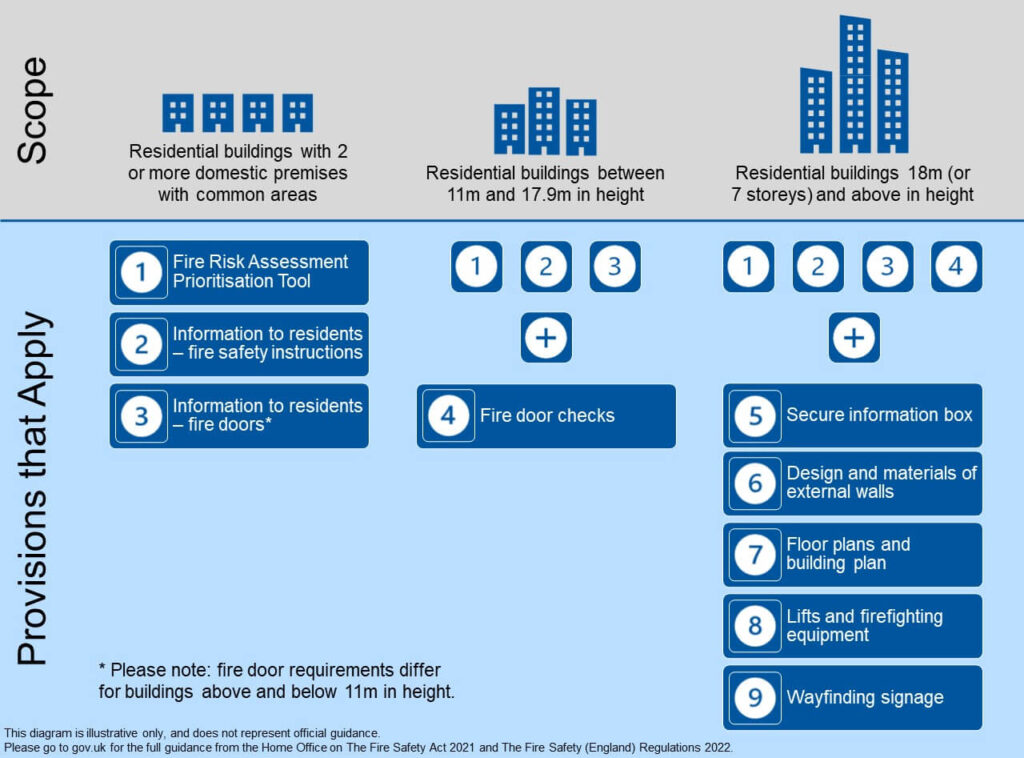
Source: https://www.nationalfirechiefs.org.uk/Fire-Safety-Act-2021-and-Fire-Safety-England-Regulations-2022
- Fire Risk Assessment Prioritisation Tool
- Information to residents – fire safety instructions
- Information to residents – fire doors
- Fire door checks
- Secure information box
- Design and materials of external walls
- Floor plans and building plan
- Lifts and essential fire-fighting equipment
- Wayfinding signage
We will now look at each of these in more detail.
Scope
Residential buildings with 2 or more domestic premises with common areas
Provisions that Apply: 1, 2 and 3
Residential buildings between 11m and 17.9m in height
Provisions that Apply: 1, 2, 3 and 4
Residential buildings 18m (or 7 storeys) and above in height
Provisions that Apply: 1, 2, 3, 4, 5, 6, 7, 8 and 9
Provisions
1. Fire Risk Assessment Prioritisation Tool
The PPRU has supported the Home Office Task and Finish Group in the production of a new Fire Risk Assessment Prioritisation Tool (FRAPT). The FRAPT is an online tool designed to assist responsible persons to develop a strategy to prioritise their buildings to review their fire risk assessments, to ensure they take into account the clarifications outlined in the Act.
The Fire Risk Assessment Prioritisation Tool can be found at the – Fire Safety Act 2021 – GOV.UK (www.gov.uk)
This approach is also designed to ensure that competent professionals who have the required skills to assess external walls (such as fire engineers, fire risk assessors, surveyors, or architects) prioritise their resources to buildings identified as high priority.
The Fire Risk Assessment Prioritisation Tool does not constitute a fire risk assessment in itself, nor does it remove the need or requirement for both FRS’s and RPs to act upon known or suspected risk in all premises.
How Can DDS International Help?
- All of the required information for the FRAPT is already available and collected in PYRAMID when an FRA is completed.
- The FRAPT can be completed in-house or DDS can help support and submit in addition to the FRA process.
2. Information to residents – fire safety instructions
To provide all residents with relevant fire safety instructions on how to report a fire and what to do once a fire has occurred
How Can DDS International Help?
DDS can support with;
- A standardised template of resident instructions for you to amend
- A standardised template for display signage.
3. Information to residents – fire doors
To provide residents with information relating to the importance of fire doors as part of general fire safety
How Can DDS International Help?
DDS can support with;
- A standardised template of resident instructions for you to amend
- A standardised template for display signage.
4. Fire door checks
Annual and quarterly fire door checks
- RP’s must endeavour to undertake annual checks of flat entrance doors
- RP’s must undertake quarterly checks of all fire doors in the common parts
How Can DDS International Help?
Quarterly fire door checks
- DDS has a Quarterly Fire Door Check on the PYRAMID System
- This can be used in-house or DDS can survey
Annual Fire Door Surveys
- DDS has accredited Fire Door Inspectors
- DDS also has a fire door survey on the PYRAMID system
- DDS can help support for all your Fire Door Survey requirements.
5. Secure information box
To install and maintain a secure Premises Information Box (PIB) within the building
The PIB must contain the name and contact details of the RP and hard copies of the building floor plans.
This code of practice ALSO applies to the provision of PIBs within the following types of premises:
- existing blocks of flats whose top storey floor height is below 18m or under six storeys which have additional complexity i.e. layout, access, floor numbering, flat numbering, firefighting facilities, fire engineering etc;
- student accommodation designed like a block of flats, e.g. those adopting a stay put approach whose top storey floor height is 11m or more;
- new build blocks of flats whose top storey floor height is 11m or more.
How Can DDS International Help?
As part of your FRA we record if locations have a PIB.
The assessor will also call out in the new FRA template if the contents of the PIB are present.
6. Design and materials of external walls
To provide the FRS with information about the design and materials of a high-rise building’s external wall system, and of any material changes to these walls.
To provide the FRS with information relating to the level of risk that the design and materials used in the external wall structure give rise to and any mitigating steps taken.
How Can DDS International Help?
As part of your FRA we record observations during inspection, such as:
- External facade
- External cladding
- Other external construction elements present.
And where an EWS1 is provided, we confirm the details above within the report.
The assessor will also highlight if there are any concerns.
7. Floor plans and building plan
To provide the FRS with up-to-date building floor plans by electronic means.
To place a hard copy of these plans, alongside a single page building plan which identifies key firefighting equipment, in a secure PIB on site.
This code of practice ALSO applies to the provision of PIBs within the following types of premises:
- existing blocks of flats whose top storey floor height is below 18m or under six storeys which have additional complexity i.e. layout, access, floor numbering, flat numbering, firefighting facilities, fire engineering etc;
- student accommodation designed like a block of flats, e.g. those adopting a stay put approach whose top storey floor height is 11m or more;
- new build blocks of flats whose top storey floor height is 11m or more.
How Can DDS International Help?
As part of your FRA we record if building plans are held electronically and if locations have a PIB.
The assessor will also highlight in the new FRA template if the contents of the PIB are present.
DDS can attend site to complete and provide electronic building and floor plans.
8. Lifts and essential fire-fighting equipment
Lifts and other key fire-fighting equipment: undertake monthly checks on the operation of lifts intended for use by the FRS, and evacuation lifts in the building, and check the functionality of other key pieces of fire-fighting equipment.
RP’s will also be required to report any defective lifts or equipment to their local FRS as soon as possible after detection if the fault cannot be fixed within 24 hours, and to record the outcome of checks and make them available to residents.
How Can DDS International Help?
DDS has a monthly check on PYRAMID which can be used in-house.
9. Wayfinding signage
To install signage visible in low light or smoky conditions that identifies flat and floor numbers in the stairwells of relevant buildings.
How Can DDS International Help?
DDS can provide “wayfinding signage”
The assessor will also highlight in the new FRA template if the signage is compliant.
Conclusion
The Fire Safety (England) Regulations 2022 will come into effect on 23 January 2023. If you are a responsible person, it is important to understand these new regulations and how they may impact your business. To help you stay compliant with the new regulations, our team of experts offers a range of services. Contact us today to learn more about how we can help you meet the requirements of the Fire Safety (England) Regulations 2022.

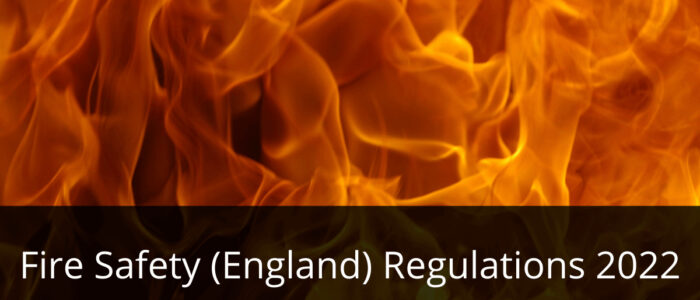
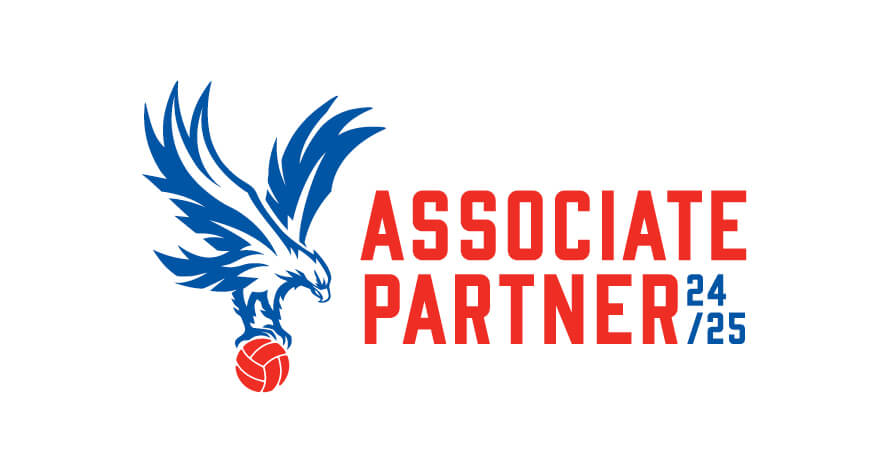
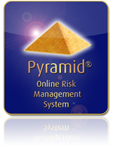


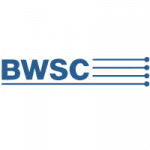


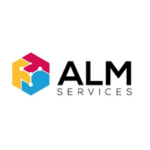
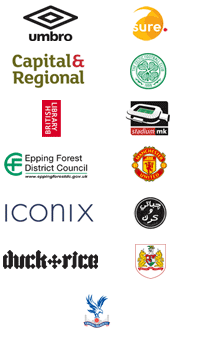
Comments are closed.